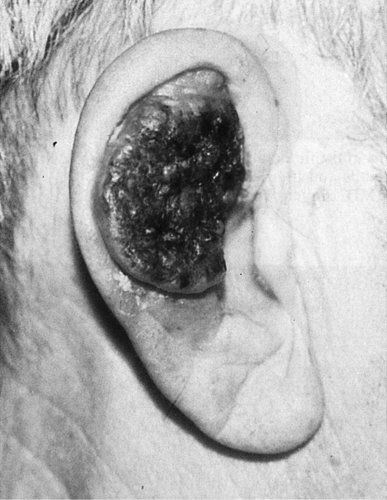Basal cell carcinoma. (With permission from Mulholland MW, Lillemoe KD, Doherty GM, Maier RV, Upchurch GR, eds. Greenfield’s Surgery. 4th ed. Philadelphia, PA: Lippincott Williams & Wilkins; 2005.)
•Risk factors
•Blond or red hair, blue or green eyes, fair skin, ultraviolet light exposure, smoking, immunosuppression, and exposure to ionizing radiation, coal tar, and arsenic
•Genetic factors that predispose to BCC
•Xeroderma pigmentosum
•Nevoid BCC syndrome (Gorlin syndrome)
•Bazex syndrome
•Rombo syndrome
•Albinism
•Hyperactivation of the sonic hedgehog (SHH) pathway is commonly found in BCC. Loss of function mutations in the SHH inhibitor patched homolog 1 (PTCH1) have been implicated in familial and sporadic BCC.
•p53 mutation in 50% of sporadic BCCs
•Can occur anywhere on the body but 80% occur on the head and neck, particularly on the nose
•BCCs grow slowly and less than 1% metastasize
•The classic lesion—nodular BCC—presents as a slow-growing, translucent, elevated nodule
•Other variants include sclerosing, superficial, and ulcerating
Treatment of Basal Cell Carcinoma
•Management options include surgical resection, Mohs surgery, electrodessication and curettage, cryotherapy, radiotherapy, laser phototherapy, and topical agents
•Electrodessication, cryosurgery, and laser phototherapy are destructive and do not permit pathologic review
•Mohs micrographic surgery is the treatment of choice for high-risk lesions and for many facial BCCs
•Electrodissection and curettage are the treatment of choice for small (<2 mm) lesions with 5-year cure rates of 95%
•Surgical excision of superficial and nodular BCC can have 5-year cure rates of 99% for lesions on the trunk and 92% or greater for lesions on the face depending on size
•Radiotherapy can be used in poor surgical candidates or for tumors in areas that are difficult to excise
•Topical imiquimod is FDA approved for small (<2 cm) superficial BCCs that are not on the head
•Vismodegib, a hedgehog pathway inhibitor, has been FDA approved for metastatic BCC or BCC otherwise refractory to surgery or radiation
BCC is the most common cancer of the body, and is characterized by a pearly white lesion with a rolled border and underlying telangiectasia. These lesions rarely metastasize, but can be locally aggressive and have a predilection for local recurrence.
A 50-year-old man presents with a 2.5 × 1.5 cm SCC of the lip, with pain in the distribution of the right mental nerve. The patient has a 2.0-cm palpable node in his right neck. Radiographic workup is negative for metastatic disease. What is the next step in management?
This patient has pain in the distribution of the mental nerve, suggesting invasion of adjacent structures. A local excision should be performed with a regional lymphadenectomy.

Squamous cell carcinoma. (With permission from Mulholland MW, Lillemoe KD, Doherty GM, Maier RV, Upchurch GR, eds. Greenfield’s Surgery. 4th ed. Philadelphia, PA: Lippincott Williams & Wilkins; 2005.)
Squamous Cell Carcinoma
•Second most common non-melanoma skin cancer accounting for 15% to 20%
•Most commonly found on the head and neck
•Head and neck (especially lower lip) lesions are common in men and lower leg lesions in women
•Presents as papules, plaques, or nodules with hyperkeratosis or ulceration
•Central ulceration is typical of poorly differentiated SCCs
•Grows faster than BCCs and can metastasize
•The risk of SCC seems to correlate with cumulative sun exposure as opposed to BCC and melanoma, which correlate more with episodic exposure to intense sunlight
•Risk factors
•UVB exposure is the major risk factor; UVA also plays a role
•Ionizing radiation exposure
•Immunosuppression
•Actinic keratosis
•Human papillomavirus infection
•Burns—SCC arising in a burn wound is known as Marjolin ulcer
•Chronic, non-healing wounds
•Genetic predisposition—Xeroderma pigmentosum, epidermolysis bullosa, albinism
•Mutations in p53 are common
•Bowen disease—SCC in situ
•10% turn into invasive SCC
•Treatment: Excision with negative margins
•Erythroplasia of Queyrat—SCC of the penis
•Red, velvety plaque
•Diagnosis
•Biopsy—punch, shave, or excisional
•Pathology: Atypical keratinocytes with keratin pearls
Treatment of Squamous Cell Carcinoma
•Options include surgical resection, Mohs surgery, electrodessication and curettage, cryotherapy, radiotherapy, laser phototherapy, and topical agents
Stay updated, free articles. Join our Telegram channel

Full access? Get Clinical Tree


